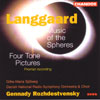Langgaard Music of the Spheres; (4) Tone Pictures
View record and artist detailsRecord and Artist Details
Composer or Director: Rued Langgaard
Genre:
Orchestral
Label: Chandos
Magazine Review Date: 9/1997
Media Format: CD or Download
Media Runtime: 53
Mastering:
DDD
Catalogue Number: CHAN9517

Tracks:
| Composition | Artist Credit |
|---|---|
| Music of the Spheres (Sfaerernes Musik) |
Rued Langgaard, Composer
Danish National Radio Choir Danish National Radio Symphony Orchestra Gennady Rozhdestvensky, Conductor Gitta-Maria Sjöberg, Soprano Rued Langgaard, Composer |
| (4) Tone Pictures (Tonebilleder) |
Rued Langgaard, Composer
Danish National Radio Symphony Orchestra Gennady Rozhdestvensky, Conductor Gitta-Maria Sjöberg, Soprano Rued Langgaard, Composer |
Author:
Fitful though they have been, Chandos’s issues devoted to the works of Rued Langgaard (1893-1952) have been especially welcome for their excellence of production. Thus far Chandos have featured four of his 16 symphonies and a tone-poem, conducted by Jarvi and Segerstam (12/92). Now, with Rozhdestvensky at the helm, they have turned to what is probably this composer’s most important – certainly most original – work, Music of the Spheres (1916-18). So radical did its sonic experiments seem even in the late-1960s that Ligeti no less, when inspecting the score, quipped that he had merely been a “Langgaard imitator” all along. The manipulation of blocks of sound rather than conventional thematic development does have much in common with trends in post-Second World War avant-garde composition (though stemming from impressionism), but other contemporaries of Langgaard’s, such as Schoenberg and Scriabin, had traversed similar terrain at least in part. The main difference between Langgaard and Ligeti lies in the former’s reliance on a fundamentally tonal language, however eccentrically deployed, and Music of the Spheres seems in hindsight to be a bridge between two other highly virtuosic scores with celestial connotations: Holst’s The Planets and Ligeti’s Atmospheres. The Tone Pictures (1917) were written alongside this extraordinary work, yet possess none of its stature: four charming songs, they seem effusive and outmoded by comparison.
Fine as John Frandsen’s pioneering account of Music of the Spheres still is, this newcomer is a markedly better all-round version. As interpretations both have much to offer, the principal differences being ones of internal balance. But the playing of the Danish orchestra for Chandos has gained much in fluency and security over that in 1980 (though admittedly the latter was for a public performance), and Chandos’s sound is of demonstration quality. This really is a disc you should hear.'
Fine as John Frandsen’s pioneering account of Music of the Spheres still is, this newcomer is a markedly better all-round version. As interpretations both have much to offer, the principal differences being ones of internal balance. But the playing of the Danish orchestra for Chandos has gained much in fluency and security over that in 1980 (though admittedly the latter was for a public performance), and Chandos’s sound is of demonstration quality. This really is a disc you should hear.'
Discover the world's largest classical music catalogue with Presto Music.

Gramophone Digital Club
- Digital Edition
- Digital Archive
- Reviews Database
- Full website access
From £8.75 / month
Subscribe
Gramophone Full Club
- Print Edition
- Digital Edition
- Digital Archive
- Reviews Database
- Full website access
From £11.00 / month
Subscribe
If you are a library, university or other organisation that would be interested in an institutional subscription to Gramophone please click here for further information.




